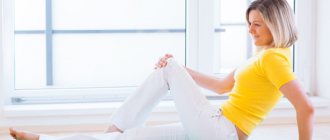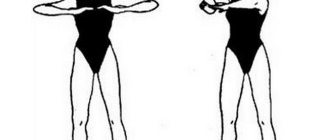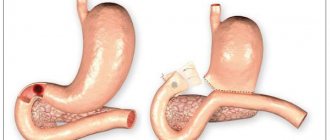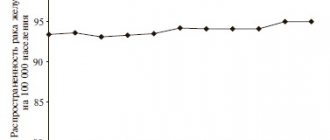Gastrointestinal diseases can be caused by various reasons (including bacterial infection), they are treated mainly with conservative methods, and rehabilitation after a stomach ulcer means recovery from an exacerbation of the disease. But in some cases, surgery or other invasive measures are indicated, and then recovery is carried out according to the same rules as in the postoperative period.
How effective is rehabilitation after a stomach ulcer?
From a medical point of view, rehabilitation after a gastric ulcer is a whole set of measures that should help restore the function of this organ after an exacerbation of the disease or after surgery. This complex should be combined with drug antiulcer therapy. Also, rehabilitation after a stomach ulcer includes:
- Therapeutic diet. During this period, split meals are recommended; food should have a liquid or puree consistency. All foods that provoke excess production of gastric juice - chocolate, smoked meats, spices - are excluded from the diet. Fermented milk products and even bread will be allowed only 2-4 months after the exacerbation and hospitalization. To recover from an ulcer, dishes should be warm, but not hot;
- Physiotherapeutic procedures;
- Physical therapy taking into account all restrictions and contraindications. This includes breathing exercises and various muscle exercises;
- Therapeutic massage to improve blood circulation and function of the gastrointestinal tract;
- Psychotherapeutic techniques.
If you are recovering from a stomach ulcer after surgery, your doctor may prescribe spa treatment. In sanatoriums, in addition to the use of mineral waters, other methods are used.
As a result of rehabilitation procedures after a stomach ulcer:
- blood circulation improves and the production of digestive enzymes is normalized;
- scarring of the ulcer is accelerated;
- the functioning of the gastrointestinal tract as a whole is normalized, since congestion in the gastrointestinal tract is prevented;
- the production of buffer compounds is stimulated, which protect the stomach from the effects of acids and prevent recurrent bleeding.
With the right approach to the recovery period, appetite is normalized and overall well-being improves.
Exercise for stomach ulcers
When the disease is diagnosed, people who prefer a physically active lifestyle are tormented by the question: is it allowed to play sports with a stomach ulcer? It is known that the main provocateur of the disease is constant stress, food comes in second place. If we are talking about a stomach ulcer, playing sports during the recovery process of the body is quite useful for the patient. Methods are described to help cope with the cause of the disease. Strengthening exercises are often prescribed by your doctor.
As for professional sports, the nature of constant training is heavy and exhausting loads in tandem with the main enemy of the body, psychological stress, which does not bring any benefit to therapy, on the contrary, provoking exacerbations! In such a case, a doctor’s consultation is necessary; each patient is individual. Perhaps the doctor will tell you the right steps.
The chosen behavior depends on the type of sport and the stage of the disease. If there is an acute period, treatment occurs in a hospital, they don’t talk about sports. If the patient’s condition is at the stage of waiting for an exacerbation every minute, it is important to understand that physical activity with an ulcer will simply provoke the onset of the disease, due to stress on the abdominal press.
Physical activity: for or against
There are two types of physical activity. The first type is professional sports, directly related to heavy loads. The work is accompanied by repeated stress, due to long and grueling training, and frequent performances in front of audiences. Sports activities will have to be postponed. There is a direct threat to the body, leading to uncontrollable complications during illness.
The second type is moderate loads. This type of exercise is useful, in some cases even therapeutic. During remission from an ulcer, reasonable exercise is necessary for the body. Exercises promote scarring of erosions and improve blood flow in the abdominal organs. Often the attending physician deliberately makes appointments for classes. But physical activity for stomach ulcers should not be debilitating. The main task is to strengthen the human body. Only in this case does physical education act as an assistant.
Despite their undeniably beneficial properties, sometimes physical activity of any degree of difficulty becomes taboo for the patient:
- In case of complications of the disease in the form of bleeding;
- Stenosis in the balancing stage;
- The appearance of severe pain;
- If there are contraindications to exercise;
- The appearance of a new, fresh ulcer, which is in the inflammatory stage.
Contraindications to physical activity during rehabilitation
The basis of physical rehabilitation for peptic ulcer disease is special gymnastics. But it is not carried out if there are contraindications:
- exacerbation of peptic ulcer;
- the appearance of bleeding;
- presence of malignant tumors (or suspicion of them);
- when ulcerative processes spread after penetration to other organs;
- other systemic diseases.
The decision on the advisability of prescribing physical therapy is made by the doctor.
Diabetes
At all stages of human existence, movement and physical activity have been an integral part of people's lives. The modern way of life has brought its negative fruits. The more comfort in the outside world, the less natural physical activity. This led to the emergence of the so-called “diseases of civilization” - diabetes mellitus, angina pectoris, atherosclerosis, obesity (the most common cause of type 2 diabetes mellitus). The number of patients with diabetes is highest in industrialized countries, meaning there is a direct relationship between decreased levels of physical activity and diabetes. Japanese researchers have concluded that among people who own a car, the incidence of type 2 diabetes is higher than among those who walk.
Recent studies by American diabetologists show that patients with diabetes who regularly exercise have a more favorable prognosis for the development of complications: retinopathy, nephropathy, neuropathy. If complications already exist, then with regular exercise they develop much more slowly.
With regular physical activity, the breakdown of fats increases, body weight decreases, and the fat composition of the blood improves. This eliminates the prerequisites for the development of atherosclerosis and other vascular diseases.
Physical activity also has a significant impact on carbohydrate metabolism. During intense physical activity, the sensitivity of insulin receptors to insulin increases, which leads to a decrease in blood sugar. This mechanism operates not only during physical activity, but is also strengthened during regular physical education and sports, which allows for better control of diabetes.
What is the most optimal way to distribute physical activity throughout the day? It is best to do gymnastics in the morning, and strength exercises are recommended to be left for 16-18 hours of the day.
Given that many patients with type 2 diabetes have comorbidities, not everyone is eligible for intense physical activity.
But there are a number of general recommendations that will suit everyone:
• The most suitable types of physical activity are walking, swimming and cycling . For those who are just starting to exercise, the duration of exercise should increase gradually from 10 minutes to 45-60 minutes per day.
• Regularity and consistency of physical activity is important . They should be at least 3 times a week.
• Monitoring blood glucose and your own well-being is necessary . If blood sugar is below 4.0 mmol/l or above 15 mmol/l, then exercise should be postponed until glucose normalizes.
Diabetes is a significant risk factor for cardiovascular disease, and lack of physical activity further increases the risk of complications. Exercising regularly will help improve your glucose levels and reduce your risk of heart disease at the same time.
So, stop thinking of exercise as less effective in preventing and treating type 2 diabetes than diet or medication. Physical activity is truly one of the best “medicines” you can find!
Physical rehabilitation and its features
Physical recovery from a stomach ulcer occurs differently depending on the stage. In this regard, different exercise therapy complexes are prescribed.
Stages of physical rehabilitation
The first stage begins during bed rest. If the ulcer worsens, the patient is hospitalized. The first stage of physical rehabilitation begins 2-4 days after hospitalization. After two weeks, the second stage begins. The third stage is carried out in a sanatorium or at home.
Early stage
If there are no contraindications, then physical rehabilitation after gastric ulcer surgery can be started in the early stages. Exercises should be done while lying on your back. The muscles must be completely relaxed; this stage takes up to 14 days. At this time, breathing exercises are performed. Breathing exercises will help relieve pain and normalize sleep.
At this time, even conventional exercise therapy is prohibited, which can lead to an increase in intra-abdominal pressure. Only the simplest exercises are allowed. The number of repetitions is no more than 2-3 times. All exercises should be performed slowly. The duration of the lesson is 15 minutes.
Second phase
This stage involves longer gymnastics sessions. But the muscles of the abdominal wall are not involved; the load remains gentle. Exercises are performed lying on your back. Gymnastics is done under the supervision of a medical professional; such services are offered by centers that provide rehabilitation for adults.
Rehabilitation of the third period
It is carried out only after the onset of remission. At this time, exercises for all muscle groups are recommended. If the patient has no complaints about health, then you can use sports equipment - expanders and dumbbells, but not more than 2 kg. The trainer can give exercises to improve coordination. In sanatoriums, under the supervision of a medical professional, training can last for half an hour.
The patient can play sports games. Hiking and even cross-country skiing in winter are recommended. At this stage, gentle massage is also allowed. The duration of the session is up to 30 minutes, but it is better to start with 10 minutes.
results
In the control group of 129 patients, 101 (78.3%) had a perforated ulcer sutured, usually with a double-row suture with an absorbable braided thread. In 28 (21.7%) patients, the Oppel-Polikarpov suturing method was used with tamponade of perforation with a strand of the greater omentum. The operation was completed by sanitation of the abdominal cavity and its drainage, usually 2 drainages. In the main group, 72 (93.5%) patients underwent suturing of the ulcer with an intracorporeal “sliding” interrupted single-row suture with a 2/0 absorbable braided thread. In 5 (6.5%) patients of the main group, a method of suturing the perforation hole was used with strengthening the greater omentum with a strand. The dimensions of the perforations in the control group were 0.7–1.5 cm, in the main group – 0.5–1.0 cm. During laparoscopic interventions, sanitation of the abdominal cavity was performed by aspiration of the leaked gastroduodenal contents without irrigation. Drainage of the abdominal cavity was performed in 32 (41.6%) patients with one drainage. In the control group, the drainage was removed on days 2–5 of the postoperative period. In the main group, if drainage was present, it was removed on the 1st day of the postoperative period.
In the control group, traditional management of the postoperative period was carried out: nasogastric intubation until resolution of intestinal paresis, activation of patients on days 2–3 after surgery, fluid intake starting from the 3rd day after surgery, oral nutrition from the 4th day. At the end of the operation, 61 (47.3%) patients were transferred to the intensive care unit, where therapy was carried out for 1 day. There were no postoperative surgical complications in the control group. The mortality rate was 2.3% (3 patients died). The causes of death were cardiopulmonary complications and pulmonary embolism (PE). The average length of stay of patients in the hospital during the postoperative period was 8.1 days.
The accelerated rehabilitation protocol included transfer of patients to the surgical department immediately after surgery; the nasogastric tube was removed at the end of surgery, the catheter from the bladder - 2 hours after surgery; patients were activated within 2 to 5 hours after surgery. Fluid intake began on the 1st day of the postoperative period, oral nutrition - from the 2nd day. The drainage from the abdominal cavity was removed the next day after surgery. A postoperative complication occurred in 1 (1.3%) case - failure of the sutures on the sutured perforation. The cause of the complication was the underestimation of infiltrative changes around the ulcer and the size of the perforation hole. The patient was re-operated on the 2nd day after surgery, open suturing of the perforation hole was performed according to Oppel-Polikarpov. There were no deaths in the main group, and the average length of stay of patients in the hospital was 4.8 days.
Patients in both groups received antiulcer therapy with proton pump blockers (esomeprazole, pantoprazole) in the first hours of the postoperative period. Within 2 days after surgery, all patients were treated with injectable forms of proton pump inhibitors; subsequently, the patients were transferred to oral administration of the drugs.
How to lift weights without harming your spine?
Adviсe:
- Always place your feet so that they are shoulder-width apart. This will help you properly distribute your weight throughout your body and not harm your spine.
- Always try to lift the load so that your legs bear the brunt of the load, not your back.
- Keep the load close to your body, not at arm's length
- Never bend your back when lifting or carrying heavy objects
IMPORTANT: Do not hesitate to ask for help if you need to lift something heavy and always think in advance about how you will lift a heavy object before the actual action.
Tips for lifting weights
How to lift weights and perform physical work correctly?
Why is it harmful to lift heavy weights?
Carrying heavy or large loads in your hands is contraindicated for any person. The fact is that a heavy burden can directly affect human health, every system of the body. Until the age of 25 (medical point of view), the spine is formed, which means that frequent lifting and carrying heavy objects can damage and bend it.
IMPORTANT: Loads will have a particularly negative impact on the formation of the skeleton of children and adolescents. This is why health problems such as scoliosis and even intervertebral and umbilical hernias appear.
Even the male body, which is more suited to physical labor and lifting heavy things than the female, can be vulnerable to heavy loads. Frequent lifting of heavy loads and bags (with improper distribution of their weight) can contribute to the formation of chondrosis, damage to the vertebrae and their displacement, as well as pinching, bone fracture, and radiculitis.
Women need to be more careful with lifting weights because their bones and skeleton are much more delicate than men's and they are more fragile. In addition, displacement of all internal organs may occur, as well as prolapse of the uterus, which can lead to infertility.
What are the consequences of heaviness?






